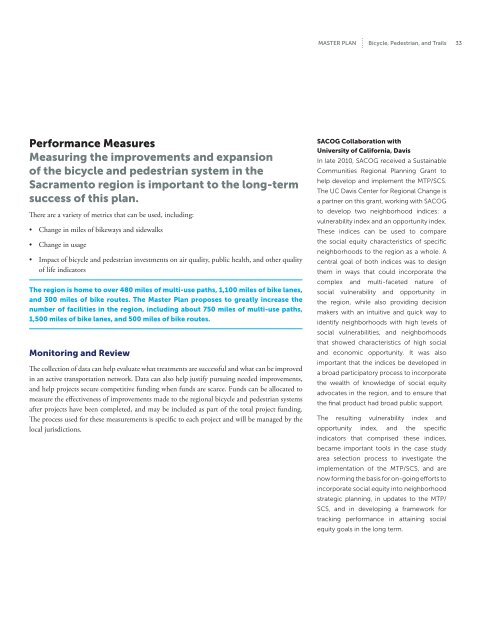Regional Bicycle, Pedestrian, and Trails Master Plan - sacog
Regional Bicycle, Pedestrian, and Trails Master Plan - sacog
Regional Bicycle, Pedestrian, and Trails Master Plan - sacog
You also want an ePaper? Increase the reach of your titles
YUMPU automatically turns print PDFs into web optimized ePapers that Google loves.
<strong>Master</strong> <strong>Plan</strong> <strong>Bicycle</strong>, <strong>Pedestrian</strong>, <strong>and</strong> <strong>Trails</strong> 33<br />
Performance Measures<br />
Measuring the improvements <strong>and</strong> expansion<br />
of the bicycle <strong>and</strong> pedestrian system in the<br />
Sacramento region is important to the long-term<br />
success of this plan.<br />
There are a variety of metrics that can be used, including:<br />
• Change in miles of bikeways <strong>and</strong> sidewalks<br />
• Change in usage<br />
• Impact of bicycle <strong>and</strong> pedestrian investments on air quality, public health, <strong>and</strong> other quality<br />
of life indicators<br />
The region is home to over 480 miles of multi-use paths, 1,100 miles of bike lanes,<br />
<strong>and</strong> 300 miles of bike routes. The <strong>Master</strong> <strong>Plan</strong> proposes to greatly increase the<br />
number of facilities in the region, including about 750 miles of multi-use paths,<br />
1,500 miles of bike lanes, <strong>and</strong> 500 miles of bike routes.<br />
Monitoring <strong>and</strong> Review<br />
The collection of data can help evaluate what treatments are successful <strong>and</strong> what can be improved<br />
in an active transportation network. Data can also help justify pursuing needed improvements,<br />
<strong>and</strong> help projects secure competitive funding when funds are scarce. Funds can be allocated to<br />
measure the effectiveness of improvements made to the regional bicycle <strong>and</strong> pedestrian systems<br />
after projects have been completed, <strong>and</strong> may be included as part of the total project funding.<br />
The process used for these measurements is specific to each project <strong>and</strong> will be managed by the<br />
local jurisdictions.<br />
SAcog Collaboration with<br />
University of California, Davis<br />
In late 2010, SACOG received a Sustainable<br />
Communities <strong>Regional</strong> <strong>Plan</strong>ning Grant to<br />
help develop <strong>and</strong> implement the MTP/SCS.<br />
The UC Davis Center for <strong>Regional</strong> Change is<br />
a partner on this grant, working with SACOG<br />
to develop two neighborhood indices: a<br />
vulnerability index <strong>and</strong> an opportunity index.<br />
These indices can be used to compare<br />
the social equity characteristics of specific<br />
neighborhoods to the region as a whole. A<br />
central goal of both indices was to design<br />
them in ways that could incorporate the<br />
complex <strong>and</strong> multi-faceted nature of<br />
social vulnerability <strong>and</strong> opportunity in<br />
the region, while also providing decision<br />
makers with an intuitive <strong>and</strong> quick way to<br />
identify neighborhoods with high levels of<br />
social vulnerabilities, <strong>and</strong> neighborhoods<br />
that showed characteristics of high social<br />
<strong>and</strong> economic opportunity. It was also<br />
important that the indices be developed in<br />
a broad participatory process to incorporate<br />
the wealth of knowledge of social equity<br />
advocates in the region, <strong>and</strong> to ensure that<br />
the final product had broad public support.<br />
The resulting vulnerability index <strong>and</strong><br />
opportunity index, <strong>and</strong> the specific<br />
indicators that comprised these indices,<br />
became important tools in the case study<br />
area selection process to investigate the<br />
implementation of the MTP/SCS, <strong>and</strong> are<br />
now forming the basis for on-going efforts to<br />
incorporate social equity into neighborhood<br />
strategic planning, in updates to the MTP/<br />
SCS, <strong>and</strong> in developing a framework for<br />
tracking performance in attaining social<br />
equity goals in the long term.
















